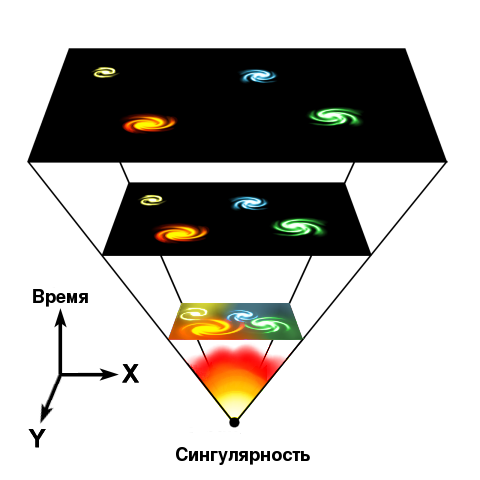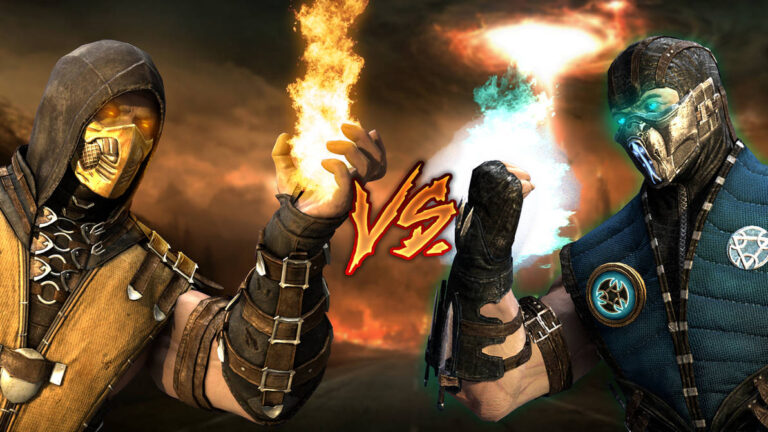Big Bang territory. From three pillars to the primordial singularity
Is it possible to empirically observe the expansion of the Universe?
If the Universe is expanding, does that mean it had a beginning?
Redshift and recession of galaxies
The answer to the first question was found quite quickly. Already by 1922, observations showed that the emission spectra of almost all known extragalactic objects redshifted, and the further away the object, the redder it is. The explanation was also quickly found: Doppler effect. If an object moves away from the observer, the observed spectrum of its radiation shifts to a longer wavelength, “red” region. For exactly the same reason, for example, the sound from a car moving away from us becomes lower.
Observations thus showed that all these objects are moving away from our Galaxy at high speeds.
And by 1929, Edwin Hubble, summarizing the work of Vesto Slifer and other scientists, published one of the most famous works in the history of cosmology, from which it followed that the hypothesis about the expansion of the Universe has ceased to be a hypothesis: The universe is really expanding. Moreover, it turned out that the further away the object, the faster it “flies away.”
If we extrapolate the expansion of the Universe into the past, we will sooner or later come up against a certain starting point in time when this expansion began: cosmological singularity – an object with an infinitely high energy density (we can, to some approximation, consider this an infinitely high temperature) and the curvature of space.
Physics cannot describe such objects. We will put this fact aside in the same place where we previously put the cosmological constant.
Where is the middle of the Universe?
Let's dwell briefly on a question that consistently causes difficulties for course participants to understand, and the name of the course is connected with it: “Territory of the Big Bang.”
I usually ask the audience a question:
If there was a Big Bang, then where exactly did it occur? If everything scatters in all directions from our Galaxy, does it mean that it is in the very center of the Universe, and the Big Bang was right here, here? How did this happen?
This question often causes confusion because at first glance it may seem that everything is true. But, of course, our Galaxy is the most ordinary and certainly not located at the center of the Universe and the Big Bang, of course, did not occur in it. So where was he? Where is the center of the universe?
To do this, let's figure out what shape the Universe has. We already discussed its curvature in the previous article, and there I made a categorical statement that the Universe is flat (however, I made a reservation in advance that almost). And now this is it almost and comes to the fore. The observable Universe is indeed indistinguishable from a flat Universe when directly observed, but refined measurements of fluctuations in the cosmic microwave background radiation (which we will talk about in more detail a little later) showed that the Universe has a slight positive curvature. And in this case, the Universe most likely has the shape of a three-dimensional sphere (3-spheres). Here it is very important to understand that this is an area that is not familiar to all of us, which is covered in the stereometry course in high school. This one has one more dimension; it is not itself that is three-dimensional, but its surface! And in this very surface our Universe is located.
This object is difficult to imagine, so, as last time, let’s consider an object with a smaller number of dimensions – just an ordinary sphere (2-sphere). Or even something less abstract: for our purposes, a good model of the expanding Universe would be an ordinary balloon with galaxies (or just dots) drawn on its surface. If this balloon begins to inflate (expand the Universe), then it will obviouslythat any two points on its surface move away from each other.
This means that from the point of view of any point, all other points move away from it. And the farther the points are from each other, the faster they move away. Dot.

It turns out that the Universe has no center, just as there is none at the surface of the 2-sphere. And the Big Bang was everywhere. Our entire Universe is the region where it occurred! That's why I called the course “Big Bang Territory.”
It should be noted that similar reasoning is valid for a completely flat Universe, without any almost. But with visual modeling of an infinite plane, some difficulties arise.
You can read more about modern research into the curvature and shape of the Universe in an excellent article by @OlegSivchenko
CMB radiation
The answer to the second question was not found so quickly.
In 1948 Georgy Gamov and colleagues put forward a hypothesis about the existence cosmic microwave background radiation – a kind of “photograph” of the Universe shortly after the Big Bang.
If the Universe arose from a singularity (no matter how strange and indescribable it may be), then for some time after its origin it was so dense and hot that its entire content, to a first approximation, was electromagnetic radiation with very high energy.
And since the Universe, according to the theory, immediately began to expand, Gamow suggested that this expansion should eventually lead to two consequences:
The energy density had to decrease, which is why the hot “energy soup” cooled down to the point that some of its photons would no longer be constantly absorbed in it, and would survive to this day
These most preserved photons, which are also electromagnetic waves, should have been “stretched”, their length should have become larger, and their frequency – that is, energy – less
Gamov appreciated effective temperature of this ancient radiation, by our time it should have cooled to about 3K (degrees Kelvinalthough using the word “degree” next to the word “Kelvin” is considered bad form in the scientific community).
But at that time it was a pure theory; Gamow did not find any experimental evidence of the existence of cosmic microwave background radiation at that time.
***
And a little more than 15 years later, in 1964, an event occurred that was no less famous in the history of cosmology than Hubble’s work on redshift: while setting up the latest antenna for astronomical research, Bell Telephone Laboratories engineers Arno Penzias and Robert Wilson discovered, that the entire cosmos uniformly radiates as an absolutely black body with a temperature of 2.7 K. This is how the cosmic microwave background radiation, theoretically predicted by Gamow, was empirically discovered. It is also called microwave background radiation or IMF.
It is interesting that the first reports of cosmic radiation of an unknown nature appeared almost 20 years earlier, but an explanation for them was found only now.
This discovery became the indisputable final proof of the truth of the Big Bang theory. Once upon a time the universe really was so dense and hot that we can directly observe the radiation of that period literally everywhere. This means that the Big Bang happened!
In what follows, I will sometimes abbreviate “The Big Bang Theory” to “TBB.”
The Big Bang in all its glory

The Big Bang Theory (TBV) is not only a well-known series, but also a shining example of a qualitative theory, convincingly confirmed by observations. And its name is another science meme. In 1948, Fred Hoyle, a proponent of Einstein's idea of an ever-expanding stationary universe, sarcastically called the moment the universe emerged from a singularity the “Big Bang”, trying to demonstrate its ridiculousness. However, the term turned out to be very successful and became commonly used.
It was a period of euphoria. The final theory of the origin and development of the Universe has been reliably proven empirically! Everything looked quite simple and harmonious:
At some point, the original singularity arose
It immediately began to expand (and cool – in full accordance with the laws of thermodynamics)
???
Profit. The universe is here and now, and there is unequivocal evidence of the first two points
But, as usually happens, everything turned out to be not so simple.
Only problems from this explosion
But no matter how brilliant TBV is, it still has weaknesses, and quite critical ones. The biggest questions are raised by the very singularity from which it all began.
Firstly, physics does not know how to describe spaces of infinite curvature and energies of infinite density. In general, if a physicist gets infinity when solving an equation, this is a clear sign of big problems. This is exactly what happened shortly before the advent of TBB when calculating the total radiation energy of an absolutely black body – the so-called ultraviolet disaster.
As a result, a whole new branch of physics emerged – quantum mechanics. But that's a completely different story.
Secondly, it is completely unclear where this original singularity came from. The law of conservation of energy is considered a fundamental principle for the Universe; there is no reason to believe that the Big Bang does not obey it. And then the question arises: where, in fact, did that incredible energy that is now contained in our rather large Universe come from, if “before” the Big Bang there was nothing, not even time.
But the problems did not end with one singularity, although the rest are no longer so obvious. As we have already found out, according to observations, the Universe has almost exactly zero curvature. This fact contradicts the TBB, since at the observed rate of expansion of space there was no way it could have time to smooth out from infinite curvature to almost almost zero.
The situation is similar with the uniformity of the microwave background. He too much homogeneous! With a uniform expansion of space, from an infinitely small size there arises horizon problem — regions of space appear that, roughly speaking, move away from each other faster than the speed of light, which eliminates the possibility of equalizing the level of radiation energy between them. When I say “moving away faster than the speed of light,” listeners usually immediately react with great skepticism. Someone even accuses me of being anti-science!
But there is no mistake here – the expansion of space is not the movement of anything material, therefore nothing prevents points in space that are sufficiently distant from each other from moving away from each other at any “speed” (remember observable universe)
But the questions for TBV do not end there either. Scientific method is based on reproducibility, on the invariability of the result under identical initial conditions. From this point of view, the Big Bang looks suspicious. This is a unique, one-of-a-kind event, as a result of which the only Universe known to us arose with a set of parameters, the values of which, as we remember from the first article, are considered random. But since we have exactly one Universe, their randomness cannot be verified in any way.
All these questions are well complemented by the fact that the scientifically proven emergence of the Universe literally came from nothing. quite quickly officially approved by the church (Christian denominations and not only). The reason is quite clear: this event is, in its essence, very similar to the act of creation.
I will conclude this article with this ambiguous statement. See you in the third part!





